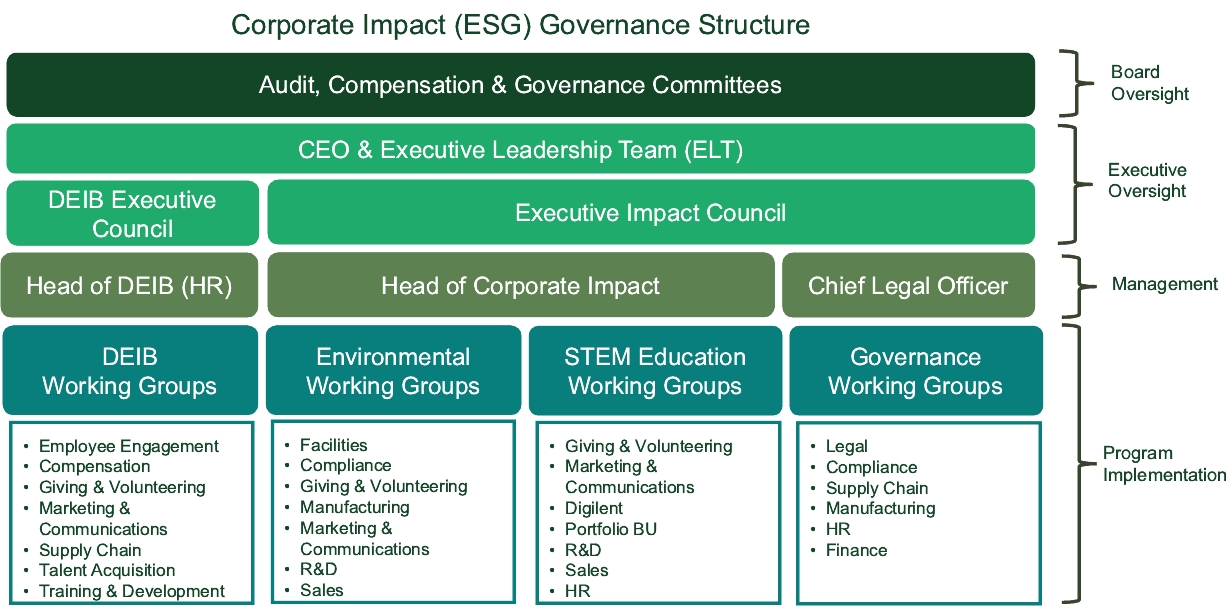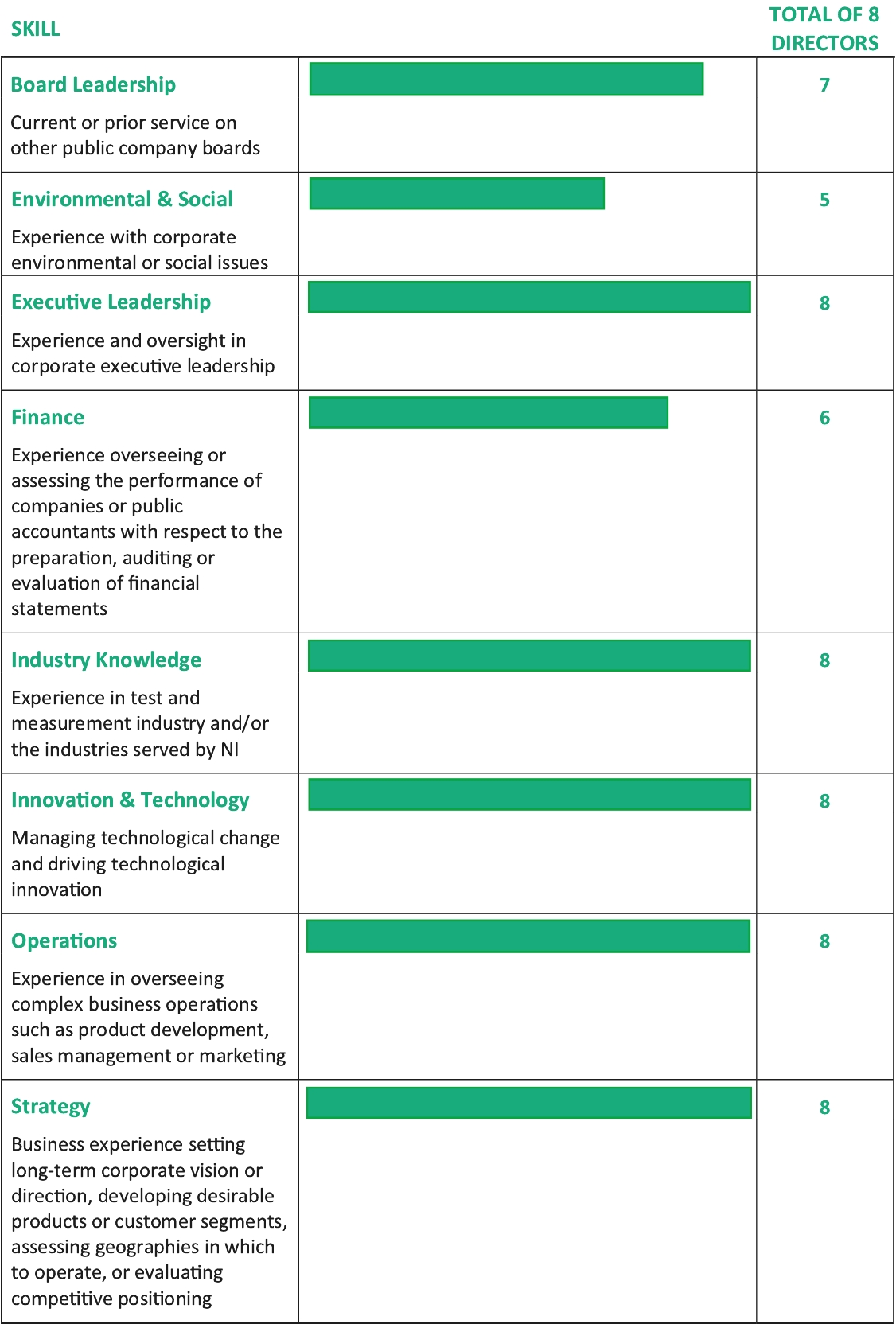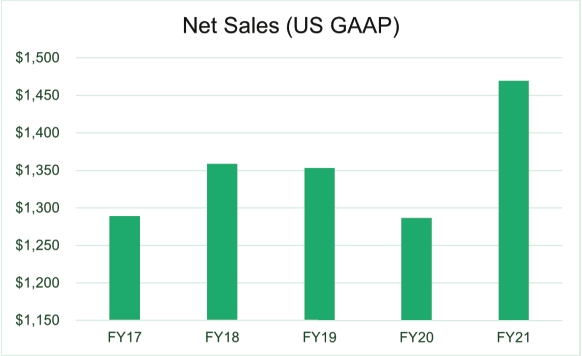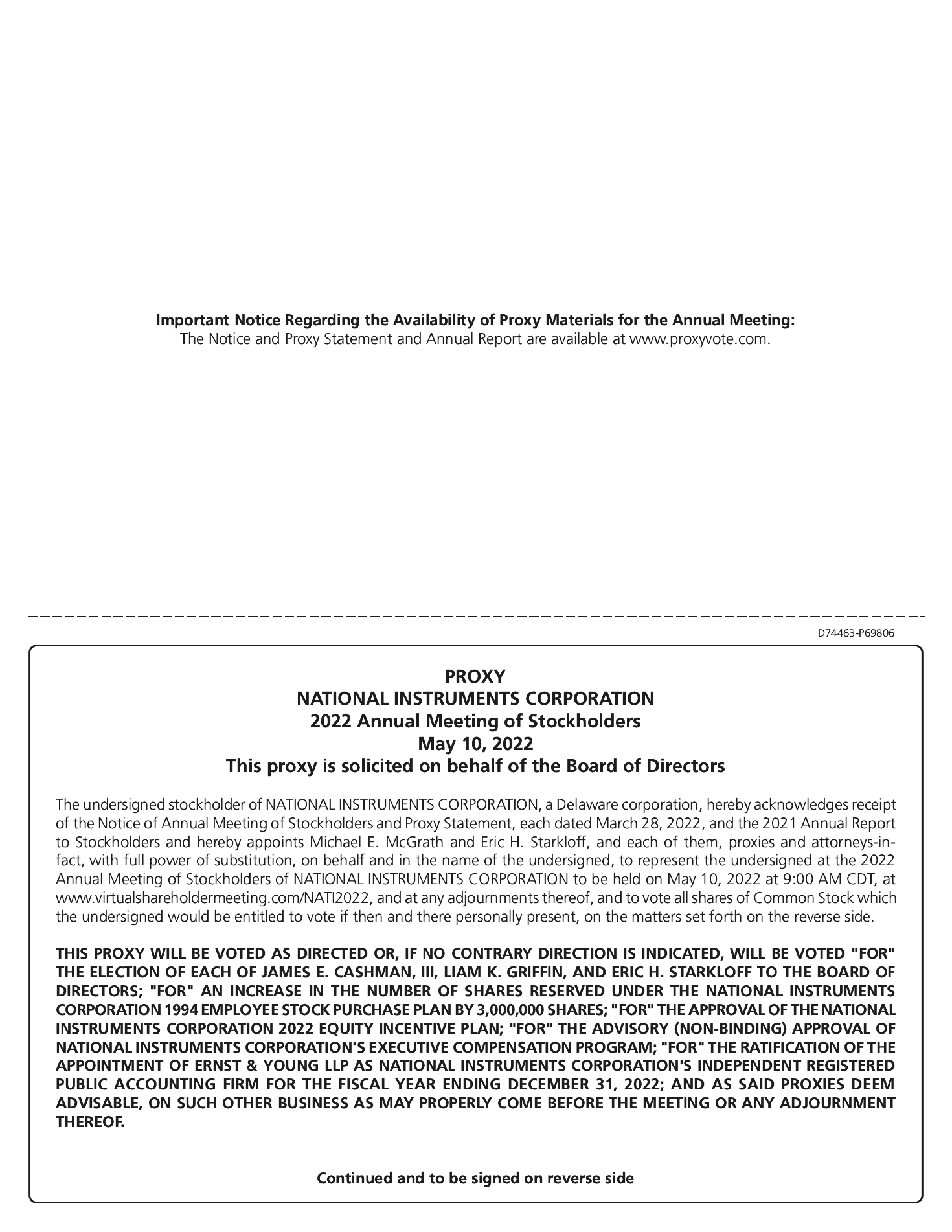COMPENSATION DISCUSSION AND ANALYSIS
This Compensation Discussion and Analysis provides information regarding the
20182021 compensation program for our principal executive officer, our principal financial officer, and the three
executive officersExecutive Officers (other than our principal executive officer and principal financial officer) at
the end of fiscal
year-end year 2021 who were our most
highly-compensated executive officers (ourhighly compensated Executive Officers (collectively, our “Named Executive Officers” or “NEOs”). The following discussion and analysis should be read in conjunction with the compensation tables
contained elsewhere instarting on page 37 of this Proxy Statement. For
2018,2021, our Named Executive Officers
were:were, with their current titles, as applicable:Alexander M. Davern,Chief Executive Officer;
Eric H. Starkloff, President and Chief Operating Officer;
Executive Officer (our “President and CEO”);Karen M. Rapp, Executive Vice President and Chief Financial OfficerOfficer;
Jason E. Green, Executive Vice President & GM, Portfolio BU and Treasurer;Chief Revenue Officer;
Scott A. Rust, Senior Vice President, Global Product Research and Development; and
John C. Roiko, Vice President, Finance and Chief Accounting Officer.
Executive Officer Change during 2018
Mr. Starkloff was appointed as our President and Chief Operating Officer effective October 23, 2018. Prior to his promotion, Mr. Starkloff had served as our Executive Vice President, Global SalesPlatform & Technology; and Marketing since January 2014 and as our Senior
Ritu Favre, Executive Vice President
Marketing, from April 2013 to January 2014. Mr. Starkloff also previously served in the roles of Vice President, Marketing, Vice President, Product Marketing, Director of Product Marketing, Product Marketing Manager, and Applications Engineer.& GM, Business Units.
This Compensation Discussion and Analysis
describesoutlines the material elements of our
2021 executive compensation program,
during 2018. It also provides an overview of our executive compensation philosophy, including our principal compensation policies and
practices. Finally, it analyzes howpractices, and
why the Compensation Committee arrived at thedescribes specific compensation decisions
made during 2021 by our Compensation Committee for our Named Executive Officers,
in 2018, and discussesincluding the key factors that the Compensation Committee considered in determining
theirour Named Executive Officers’ compensation.
Executive Summary
Who
2021 Business Highlights
We
AreForexperienced strong demand for our products throughout 2021 and continued to focus on driving efficiencies across our business. Despite some disruptions from global supply chain constraints, we were able to achieve record revenue and the highest non-GAAP operating income in more than 20 years.
Revenue: We reported net sales of $1.5 billion, an all-time record and a 14 percent increase from 2020.
Cash Generation: We generated annual cash flow from operations of $143 million. As of December 31, 2021, we held $211 million in cash and cash equivalents.
Capital Deployment: In 2021, we returned over 40 years, NI has enabled engineers$198 million to our stockholders through dividends and scientists aroundstock repurchases. We also completed the worldacquisition of several companies for total consideration of $223 million, net of cash received. These acquisitions are intended to accelerate productivity, innovation and discovery. Our software-centric platform provides an advanced approach through integration of software and modular hardwareour investments in key focus areas including vehicle electrification.
Product Portfolio: We continued to createsharpen our focus on system-level automated test and automated measurement systems. We believe our long-term track record for innovationofferings in key growth areas, including semiconductor, transportation, and our differentiated platform helps support the success of our customers, employees, suppliers,aerospace, defense, and stockholders.government.
TABLE OF CONTENTS
Say-on-Pay Vote and
Introduction of Performance-Based Restricted Stock Unit Awards
At our 2021 Annual Meeting of Stockholders, approximately 92% of the votes present and entitled to vote on the advisory vote for Named Executive Officer compensation (also known as the “Say-on-Pay” vote) voted in favor of the compensation of our Named Executive Officers. We view the stockholder advisorySay-on-Pay vote on named executive officer compensation (theso-called“Say-on-Pay”) as an opportunity to receive feedback from our stockholders about our executive compensation program. In addition,As set forth in more detail in the Introduction to this Proxy Statement, prior to our Annual Meetingannual meetings of Stockholdersstockholders, we reach out to our major stockholders toand engage with them on their views and concerns about our executive compensation
policies and practices. Prior to our 2018 Annual Meeting of Stockholders, we engaged with several of our stockholders and specifically requested feedback onpractices, including our executive compensation program. Specificcompensation.
During 2021, the Compensation Committee made no material changes to
executive compensation, the
feedback received was focused on three areas: (i) our CEO pay relative to total stockholder return, (ii) that our long-term incentive (“LTI”) program for our NEOs did not include performance-based RSUs, but instead only time-based RSUs, and (iii) a lack of transparency about our Annual Incentive Program (“AIP”) bonus goals. We listened to this feedback and have attempted to address all three concerns.At our 2018 Annual Meeting of Stockholders, approximately 58%structure of the votes cast on theSay-on-Pay proposal were voted in favor of thetotal direct compensation ofpaid to our Named Executive Officers. While this represented more than majority support ofSee the proposal, our Board of Directors recognized that these results were less than what it consideredIntroduction to be satisfactory, particularly in light of the fact that approximately 99% of the votes cast on our 2017Say-on-Pay proposal were voted in favor of our Named Executive Officers’ compensation. When considering the compensation trend of our CEO over the past several years, we note that our former CEO, Dr. James J. Truchard, was a founder and major stockholder of NI and, at his request, he received a nominal base salary of $1.00 and did not participate in our bonus plans or receive equity awards. When Alex Davern became CEO on January 1, 2017, we moved to a market-based approach to compensating our CEO. Mr. Davern’s compensation since becoming CEO is set forth in the Summary Compensation Table of this Proxy Statement. Since our former CEO was not paid any base salary, bonus or equity, we only have two years (i.e., 2017 and 2018) of meaningful compensation dataStatement for the CEO position.
In response to the stockholder feedback received in connection with our 2018 Annual Meeting of Stockholders, the Compensation Committee determined that we should add performance-based equity awards to our LTI compensation program. Accordingly, the Compensation Committee approved the introduction of performance-based restricted stock unit (“PRSU”) awards to be granted to our Named Executive Officers, beginning in January 2019. These PRSU awards represented 50% of the equity award value granted to our Named Executive Officers, with the other 50% of their award value consisting of time-based restricted stock unit (“RSU”) awards. In addition, based on stockholder feedback, we have included additional information in this Compensation Discussion and Analysis regarding the performance goals and calculation of the payouts under our AIP for executive officers for 2018.
The PRSU awards may be earned based on our total stockholder return (“TSR”) compared to the TSR of the Russell 2000 Index (the “Index”) over a three-year performance period commencing on January 1, 2019 and ending on December 31, 2021 (using the average daily closing price over a30-day lookback in each case). The number of shares of NI common stock subject to the awards will be earned from 0% to 200% of the target award based on our TSR compared to the Index as follows:
| | | | | | | | | | |
Payout Level | | TSR Percentile Rank Against
the Russell 2000 Index | | Payout Percentage of Target
Number of Shares |
Maximum
| | | | ³80th Percentile
| | | | | 200
| %
|
Stretch
| | | | 65th Percentile
| | | | | 150
| %
|
Target
| | | | 55th Percentile
| | | | | 100
| %
|
Threshold
| | | | 25th Percentile
| | | | | 50
| %
|
None
| | | | <25th Percentile
| | | | | 0
| %
|
We believe that our use of performance-based LTI compensation is important to strengthen the alignment of our executive officers’ compensation to stockholder value creation, as well as driving the achievement of NI’s financial and operational goals. In light of this belief, in January 2019, the
Compensation Committee granted PRSU awards and time-based RSU awards to our Named Executive Officers in the amounts set forth in the following table:
| | | | | | | | | | |
| Named Executive Officer | | Target PRSUs | | RSUs |
Alexander M. Davern | | | | 53,000 | | | | | 53,000 | |
Eric H. Starkloff | | | | 16,625 | | | | | 16,625 | |
Karen M. Rapp | | | | 13,006 | | | | | 13,006 | |
Scott A. Rust | | | | 8,482 | | | | | 8,482 | |
John C. Roiko | | | | 1,696 | | | | | 1,696 | |
The overall LTI equity award value for our CEO and our other NEOs was determined after consideration of multiple factors as described in the “Compensation Discussion and Analysis—Compensation-Setting Process” section of this Proxy Statement. Such factors include a competitive market assessment, the current retention incentive for each executive officer as determined by his or her current unvested equity holdings, and the amount ofnon-equity incentive plan compensation received by him or her. As indicated in the above table, the LTI award value in 2019 will be provided 50% in time-based RSUs and 50% in performance-based RSUs. As a result of the introduction of performance-based RSUs for 2019, the proportion of time-based RSUs as a percentage of total RSUs granted has been scaled back significantly relative to prior years.
One of the key tenets of our executive compensation program is to align the design of the program with the interests of our stockholders. Going forward, we will continue to carefully consider the views and concerns of our stockholders regarding our executive compensation program. Our stockholders are invited to express their views to the Compensation Committee as described under “Corporate Governance—Communications to the Board of Directors” in this Proxy Statement.
Stockholder Engagement Program
NI values governance outreach as a way to keep a pulse on the topics which are most important to our stockholders. Previous outreach efforts included requests for calls to NI’s top 25 institutional stockholders. As a result of this outreach, we successfully secured calls with 12 of our top 25 institutional stockholders in April 2018. Topics covered in these outreach discussions included the:
recommendation of the use of relative metrics such as TSR compared against an industry benchmark;
identification of a preference for performance-driven RSU grants over time-based awards;
desire to see AIP metrics for executive officers;
appreciation for focus on revenue growth, operating margin targets and retention;
acknowledgment of the need for a competitive compensation package for our CEO compared to the $1.00 annual salary paid to NI’s previous CEO andco-founder;
observation that the average tenure of NI’s board was on the high end; and
shared desire to see more diversity on the board, but also recognition of the limited pool of candidates and the difficulty in attracting diverse candidates to amid-size public company board.
Based on feedback from the stockholder engagement program, as noted above, we introduced PRSUs and we have also included additional information in this Compensation Discussion and Analysis regarding the performance goals and calculation of the payouts under our AIP for executive officers for 2018.
In recognition of the value ofabout our stockholder outreach program, we have continued our outreach efforts in early 2019 to engage in a dialogue regarding recent changes to our bylaws to allow for proxy access beginning in 2020 and changes to our executive compensation methodology where many of the recommendations from our prior outreach were implemented for 2019. In addition, effective March 2019, we will have two new independent board members with experience that maps closely to our corporate strategy. The addition of two new directors will also significantly reduce the average tenure of our Board members. We have described our Board search process (including the specific objective of identifying highly qualified diverse candidates) as a part of our outreach discussions and we will continue to focus on the diversity of our Board in the future.
We plan to continue to enhance our outreach program to drive consistent engagement and to listen and learn from our stockholders while forming strong relationships in the process.
Business Highlights
During 2018, we achieved record revenue and record operating income as illustrated in the charts below. We also achieved a number of other important financial and operational results as described below. We believe these achievements reflect the value that our platform-based approach provides to our customers and our execution on our commitment to financial and operational excellence.
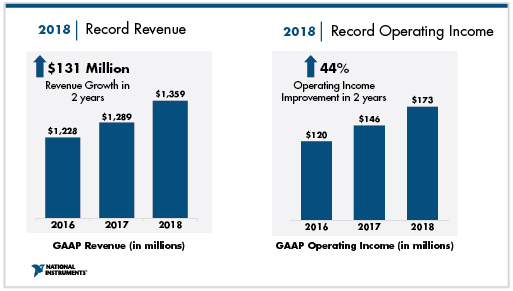
2018|Record Revenue 2018|Record Operating Income
In 2018, we achieved the following important financial and operationalresults:
| • | | Revenue:We reported record net sales of $1.359 billion, up more than 5% from the prior year. Since 2016, annual revenue has increased by $131 million, a compounded annual growth rate of 5%.
|
| • | | Financial Discipline:We reported record operating income of $173 million in 2018, up 19% from the prior year and up 44% over two years.
|
| • | | Cash Generation: We generated record annual cash flow from operations of $275 million, a year-over-year increase of 22%. As of December 31, 2018, we held $531 million in cash and short-term investments.
|
| • | | Capital Deployment:We paid $122 million in dividends to our stockholders. Our strategies for capital deployment remain the same: payment of our quarterly dividend, opportunistic share repurchases and acquisitions of strategic accelerators.
|
engagement. | • | | Flagship Software:We continued to introduce key features into LabVIEW NXG, the next generation of our flagship software platform.
|
| • | | Product Portfolio:We continued to sharpen our focus on system-level automated test and automated measurement offerings in key growth areas, including semiconductor, transportation, and aerospace, defense, and government.
|
2021 Executive Compensation Highlights
For 2018,
In 2021, the Compensation Committee took the following actions with respect to the compensation of our Named Executive Officers:
| • | | Base Salary — Approved annual base salary increases ranging from 3.5%to 9.96%, including a base salary increase of 3.6%for our CEO.
|
| • | | Annual Cash Bonusesunder Annual Incentive Program — Approved target
Entered into Employment Agreements with Four of our Named Executive Officers such that each Named Executive Officer has a double-trigger compensation arrangement in connection with a change in control – The Compensation Committee approved, and we entered into, employment agreements (including “double-trigger” change in control provisions) with each of Ms. Favre, Mr. Green, and Ms. Rapp in February 2021 and with Mr. Rust in September 2021. See “Potential Payments Upon Termination or Change of Control” below for more information. Established Named Executive Officer Base Salaries – Approved annual base salary increases for some of our Named Executive Officers ranging from 3% to 5%. One Named Executive Officer’s base salary remained unchanged for 2021. Established Named Executive Officer Executive Incentive Program (“EIP”) Targets – For our Named Executive Officers, other than our President and CEO, approved the key company financial and operational performance objectives, pre-established performance levels for each objective, and related payout levels (expressed as a percentage that increases or decreases with company performance) for cash incentive bonus opportunities for our NEOs under our AIP ranging from 20% to 80% of their 2018 annual base salary, and approved payment of an annual cash bonus for our CEO in the amount of $551,003, equal to 95% of his target annual cash bonus opportunity. |
| • | | Annual Cash Bonuses under Annual Performance Bonus Program — Approved annual cash bonus payments pursuant to our Annual Performance Bonus Program in amounts ranging from $18,584 to $48,581, including an annual cash bonus payment for our CEO in the amount of $48,581.
|
| • | | Long-Term Incentive Compensation — Granted LTI compensation opportunities pursuant to the EIP, and approved target cash incentive bonus opportunities ranging from 65% to 100% of the Named Executive Officer’s 2021 annual base salary, which, if paid at target, would result in an EIP payout for these Named Executive Officers of $307,344 to $480,000. Our Board, based on the recommendations of the Compensation Committee, approved the same EIP key company financial and operational performance objectives for Mr. Starkloff, our President and CEO. Our Board approved, at the recommendation of the Compensation Committee, a target cash incentive bonus opportunity equal to 135% of Mr. Starkloff’s 2021 annual base salary, which, if paid at target, would result in an EIP payout of $992,250. Mr. Rust’s target cash incentive bonus opportunity increased from 65% of his base salary during the first three quarters of 2021 to 100% for the fourth quarter, in connection with his promotion effective October 1, 2021, resulting in a blended annual target opportunity of 74% of his base salary. See “Executive Incentive Program below for more information regarding the EIP, including actual payouts for 2021.
Granted Named Executive Officer Equity Awards – Granted equity awards in the form of 50% restricted stock units (“RSUs”) and 50% performance restricted stock units (“PRSUs”) to be settled for shares of our common stock, in amounts ranging from target levels of $750,000 to $1,800,000, to our Named Executive Officers, other than our President and CEO, and an equivalent of $5,000,000 (40% RSUs and 60% PRSUs) to our President and CEO. Pay-for-Performance Discussion Our 2021 executive compensation program consisted of base salary, the EIP in the form of time-based RSU awards that may be settled for shares of our common stock, in amounts ranging from target levels of approximately $149,704 to approximately $2,213,100, including an RSU award for our CEO with an aggregate target value of approximately $2,213,100. |
| • | | Promotion of Mr. Starkloff — Established the following compensation arrangements for Mr. Starkloff in connection with his appointment as our President and Chief Operating Officer in October 2018:
|
an annual base salary of $525,000;
a target incentive bonus opportunity under our AIP equal to 70% of his annual base salary; and
a time-based RSU award for 25,000 shares of NI common stock, all of which will vest on May 1, 2020, subject to his continued employment on such vesting date.
In establishing these compensation arrangements, the Compensation Committee took into consideration Mr. Starkloff’s experience and skills as well as the competitive market for similar positions at other comparable companies based on a review of compensation survey data.
Pay-for-Performance Discussion
Our 2018 executive compensation program, which consisted of base salary, an annual cash bonus opportunity, under our AIP, an annual cash bonus opportunity under our Annual Performance Bonus program, LTIand long-term incentive compensation opportunities in the form of equity awards,RSUs and other benefits, wasPRSUs. The EIP metrics and payouts are closely linked to stockholder value creation through the achievement of our short-term and long-term financial, operational, and strategic objectives.






